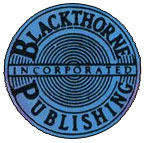Blackthorne Comics
 |
|
| Comic publisher | |
| Industry | Comics |
| Founded | 1985 |
| Founder | Steve Schanes, Ann Fera |
| Defunct | 1990 |
| Headquarters | El Cajon, California |
|
Key people
|
John Stephenson, editor-in-chief |
Blackthorne Publishing, Inc. was a comic book publisher that flourished from 1986–1989. They were notable for the Blackthorne 3-D Series, their reprint titles of classic comic strips like Dick Tracy, and their licensed products. Blackthorne achieved its greatest sales and financial success with their licensed 3-D comics adaptations of the California Raisins, but the financial loss suffered by the failure of their 3-D adaptation of the Michael Jackson film Moonwalker was a major contributor to the publisher's downfall.
Blackthorne was established in 1985 by husband-and-wife team Steve Schanes and Ann Fera, formerly associated with Pacific Comics (which had gone out of business in 1984). Schanes explained, "My abilities have always been to sell and promote, and I needed to have a job to pay my debts and to maintain a minimum life-style with my family. Since I could not locate enough work where I was living, I decided to start up another company, so I borrowed on my credit cards and started Blackthorne." Schanes and Fera raised $16,000 to start Blackthorne (naming the company after the street on which they lived), mostly using their credit cards.
Blackthorne's first title was Jerry Iger's Classic Sheena, with a cover date of April 1985, featuring Sheena, Queen of the Jungle reprints and a new Dave Stevens cover. (The book had originally been slated as a Pacific Comics release.) Despite early struggles due to their limited funds, Blackthorne steadily expanded during its first years. To increase their profitability and visibility, the company employed sales representatives which sold their comics to retail stores not covered by any comic book distributors, such as Hallmark Cards, Spencer Gifts, and 7-Elevens nationwide. By the end of 1987, according to Schanes, the company was publishing 22 comic books a month and was distributing to 900–1,200 gift stores not covered by comics distributors. Meanwhile, Blackthorne earned praise from critics and hobbyists for its reprints of classic newspaper comic strips. Schanes chose to do newspaper strip reprints because they required less financial investment and because there was little competition in the field at the time. Blackthorne immediately bought the rights for 60 different newspaper strips, even though they knew they wouldn't be able to produce most of them for years at best, to lock out any competition in the field.
...
Wikipedia
